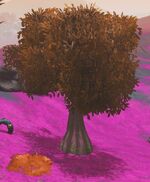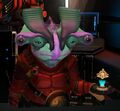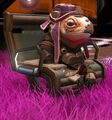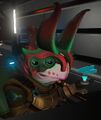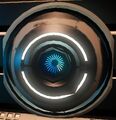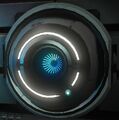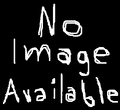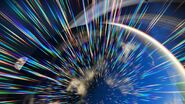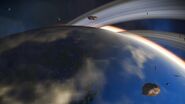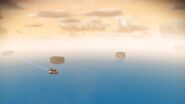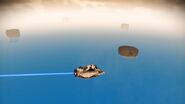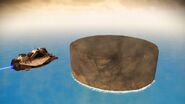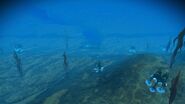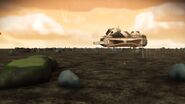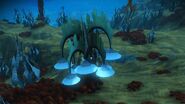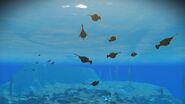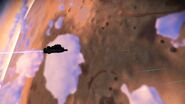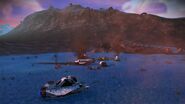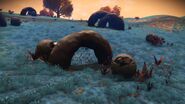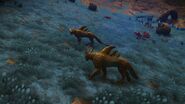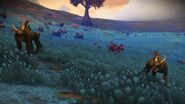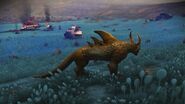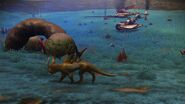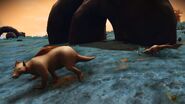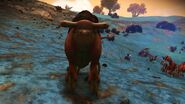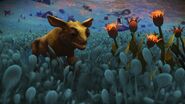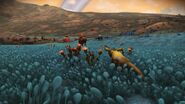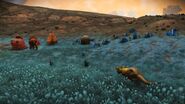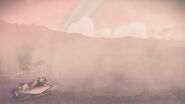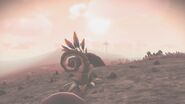| Nodershan Kone | |||
|---|---|---|---|

| |||
| General Information | |||
| Creator | Procedurally generated world | ||
| Alternate Names | Uthcar-Adl I Wormvine (nickname) | ||
| Planet Type | Overgrown Planet | ||
| Universal Location | |||
| Universe | No Man's Sky Amalgam Universe | ||
| Galaxy | Euclid Galaxy | ||
| Sector | Ospeleshv Fringe | ||
| System | Uthcar-Adl System | ||
| Position | 1st | ||
| Orbital Characteristics | |||
| Satellites | 0 | ||
| Physical Characteristics | |||
| Age | Approx. 2.08 billion years | ||
| Atmosphere | |||
| Composition | Oxygen: 69% Nitrogen: 26% Trace others | ||
| Climate | Dangerous; commonly subjected to torrential heat storms whipping across the surface every few minutes. | ||
| Surface temperature | 74.8°F (Day) 57.4°F (Night) Heatstorms: 287.8°F | ||
| Geography | |||
| Terra-Score | T3 | ||
| Liquid Hue | Red | ||
| Weather Class | Class 3 | ||
| Tectonics Class | Class 2 | ||
| Primary Core Element | Magnetized ferrite | ||
| Geology | Non-porous | ||
| Sapients | Gek | ||
| Political Information | |||
| Affiliation | Gek Empire | ||
| Government | Gek Empire | ||
| Official Language(s) | Gek | ||
| Strategic Information | |||
| Economic Value | Low; developing into an alchemical society | ||
| Major Exports | Star Bulbs, Silver, Paraffinium, Activated Copper Former: Albumen Pearl | ||
| Strategic Value | Low | ||
| Production Value | Low | ||
| Valuable To | Gek | ||
Nodershan Kone (known amongst some travelers as Wormvine for its excessive number of Angervines and Palateworms inhabiting the world) is the first planet in the Uthcar-Adl System, found within known Gek space. It is an inconsequential, "backwater" Overgrown Planet located within the Ospeleshv Fringe along the edge of the Euclid Galaxy. Flora originating from this planet, including the metamorphic Starmortar, has pollinated other planets.
With few colonists and high sentinel activity, the conflict level is considered to be perilous to the average traveler. Despite this, squadrons of merchants escort one another across the surface and occasionally land when they see other explorers along the way. The conflict on-world is not between the Gek and other sapients — it is between the colonists and the Sentinel presence.
Summary[]
Nodershan Kone is a moonless planet in the Uthcar-Adl System. It has a low radiation and toxicity level of 0.3 rad and 2.8 tox, respectively. However, superheated rain storms are extremely common, rapidly increasing the temperatures in the area to fatal levels for most travelers every few minutes, requiring them to take shelter to prevent extermination.
History[]
A mere two galactic years after the Loranche explorer Somarinoa first set foot upon the planet, the ecosystem suffered a devastating food web collapse. This miniature but significant extinction event is still fresh in the minds of the planet's few inhabitants and no in-depth study has been greenlit yet.
It is believed to be attributed to several factors across the planet that pushed the ecology beyond its limits; the main factor is two epidemics (a large spread of the Coymeleon rabies virus and the Lamadi skin disease jumping across several species) that merged into one pandemic that placed too much strain on a number of important species and then was spread globally thanks to large packs of herd animals. However, this did not actually affect aquatic species who also suffered extinctions. It was initially believed that a number of Nodershan Walkingfish had contracted both diseases and returned to the water to lay their eggs and spread the pandemic thusly, reports of massive creatures known as Abyssal Horrors in the waters is now thought to be the actual primary reasoning behind the aquatic collapse. Some local Geks have also placed some blame on Somarinoa himself, stating that he or his domesticated gekdog pet from Ilongoqungo may have accidentally brought over some viral agent on their persons that the Nodershans had no immunity towards.
Of the species, it is interesting to note that neither the Bindpimeas nor the Jakkhanas suffered a single death caused by the pandemic, at least that any sapients witnessed and recorded. Occam's razor suggests that this is due to both species' known psychic capabilities, with Bindpimeas being telepathic through a sort of hive mind and being able to warn one another about the danger, and Jakkharas being a sort of clairvoyant to know what was happening before it happened.
The process of events is as follows:
- Large meteor shower hits the planet; current anecdotal evidence suggest this brings about the Abyssal Horrors as an invasive species. At the time of the event, few take notice of the shower and none recognize the potential threat.
- Abyssal Horrors begin feeding, dropping lifeform numbers by a cumulative amount as they continue to grow in size. Those in aquatic environments burrow into submerged caves and feed primary upon shoals of Nodershan Trufflefish. Those that make landfall use the numerous sky pillar mesas as makeshift hives, hollowing them out and emerge into caverns where they mostly feed on Grabgii.

The "Ship Siblings" would sit for months together before the Hyper Son FI1 would be taken by an Ankoku survivor.
- Abyssal Horrors begin feeding, dropping lifeform numbers by a cumulative amount as they continue to grow in size. Those in aquatic environments burrow into submerged caves and feed primary upon shoals of Nodershan Trufflefish. Those that make landfall use the numerous sky pillar mesas as makeshift hives, hollowing them out and emerge into caverns where they mostly feed on Grabgii.
- Loranche hero-turned-explorer Somarinoa first sets foot on the planet alongside his pet gekdog, Bark. The two may or may not have brought extranodershannial ailments with them to the planet which the ecoysystem would have no immunity towards. Evidence in favor of this is non-existent, but has been suggested via educated guesswork.
- After a short period of exploration, Somarinoa and Bark enter cryosleep. Their current ship, the Final Daughter KS3, has a faulty stasis pod system and the timer fails to go off correctly, setting them on a course of sleep for two whole galactic years.
- Jakkhanas abandon the safety of multiple-species herds and flee to parts unknown; their clairvoyant nature is in truth an heirloom cellular memory, hinting that the Coymeleon Rabies Plague epidemic has happened before at some point in the past.
- Coymeleon rabidity state accelerates exponentially, ultimately leading to more infected bites from them that transfers their rabies onto any other creature in their vicinity.
- The Coymeleon Rabies Plague Epidemic begins. Many species are affected.
- Bindpimeas notice the chaos occurring and communicate telepathically. They move as a whole to nest upon the sky pillar mesas dotting the landscape.
- Lamadis are affected by the Coymeleon Rabies Plague in growing numbers and begin biting any species that crosses their path. Some of those that survive the encounters get the skin disease that the Lamadis are known for. This begins to transfer alongside the rabies, transforming the epidemic into a two-prong plague.
- Large herd fauna begin to unintentionally spread the plague much further than it would have otherwise traveled as the migration season hits. Thus officially starts the Food Web Collapse as important species begin to die off in rapid succession.
- Local Gek colonists take notice of the extinction event and put forth many galactic credits to hire mercenaries to help try and stop the pandemic. Despite this, not enough take the job offer and they are unable to keep on top of it. Desperate measures are mulled around.
- The once-extremely common shoals of Nodershan Trufflefish have dwindled to small pockets, which greatly concerns those colonists who live off of the ocean for sustenance. It is initially thought that Nodershan Walkingfish are traveling back into the sea and biting the creatures, though this turns out to be insignificant with most individuals instead having been consumed by Abyssal Horrors, which the Gek have no knowledge of.
- While the local Geks decide what to do, the Grabgius, Hammerhead Tsarscoop, Nodershan Walkingfish, and numerous other species become critically endangered.
- Pressures are heavy on the Grabgius, which are driven from their burrows by Abyssal Horrors only to contract the plague in droves. The Grabgius goes extinct in the wild. Luckily, a few hundred had been removed from the wild some years prior in an attempt to begin domesticating them for the lucrative galactic pets market.
- The bottom of the food web drops out from under it and hundreds of species go extinct in a matter of a few months. Many of the bodies are not recovered and mysteriously disappear, presumably consumed by the ever-growing Abyssal Horrors.
- Realizing how bad the collapse has gotten, several specimens of the Coymeleon, Hammerhead Tsarscoop, and Lamadi are taken into custody for study. Young members of these species are put into stasis. Hired hands collect eggs of Nodershan Trufflefish and Walkingfish to place into stasis, as well.
- The crew of the Ronsal-Agjy Base on the planet Kobastl Tau decide to leave post under AI observation and travel together to the last known planetary location of their boss, Somarinoa, to see what has become of him. Gek Overseer Julkataaj, Korvax Scientist Krom, and Vy'keen Corporal Kenqiul reach the planet after hitching a ride on a line of cargo vessels.
- Wild Coymeleons are put down in droves to prevent further spread of rabies. This puts intense strain upon the species and after three months it goes extinct in the wild.
- The plague begins to slow down with the extinction of the Coymeleon, but the strain is still existent as the plague runs its course in its remaining victims, as well as their own victims. The plague continues through the winter and dwindles out by spring, but not before the Hammerhead Tsarscoop and Nodershan Walkingfish also go extinct in the wild.
- In late spring, the last known wild Lamadi is shot by Corporal Kenqiul as it attempts to attack Overseer Julkataaj, nearly ending in his demise. Shaken and with Somarinoa missing for well over a year at this point with no evidence of his fate being found, Julkataaj suggests they return home. They reluctantly do so.
- By early winter, Somarinoa's stasis pod aboard the Final Daughter finally times out and he awakens to a heavily-changed world.
At this point, 60% of the fauna on the planet had been wiped out. Only a handful of species were successfully collected to hopefully reintegrate back into the food web at some point in the future.
Locations[]
Only a few named locations are known to dot the surface of the planet.
|
|
|
Life[]
Flora[]
| Name | Harvestable materials | Discoverer | Description | |
|---|---|---|---|---|
 Bugclasp (Vendolholm gluciylleum) |
Carbon Star Bulb |
Somarinoa | Aging Style: Annual (mature within several days)
Nutrient Source: Carbon Absorption Notes: Insect Habitation | |
 Crabharae (Bacalevo crabharae) |
Oxygen | Somarinoa | Aging Style:
| |
 Eggbenedict (Noctovum quilldulium) |
Somarinoa | Aging Style: Seasonal
| ||
 Heptaploid Wheat (Unspecified) |
Heptaploid Wheat | Somarinoa | ||
 Holly Yutusus (Unimmitto hollyyutusus) |
Geothermal Energy (Used as Jumpjet Energy) |
Somarinoa | Aging Style: Annual (Seasoned)
Notes: Vigorous | |
 Injektora (B. highmovehia) |
Oxygen | Somarinoa | Aging Style: Perennial (lives for decades)
| |
 Kalpatree (F. claydeseum) |
Somarinoa | Aging Style: Cyclical
Root Structure: Branching Nutrient Source: Fungal harvest Notes: True neutral | ||
 Konedragora (Unspecified) |
Pulpy Roots | Somarinoa | ||
 Meblyberry (O. rootmeblyus) |
Oxygen | Somarinoa | Aging Style: Perennial (lives for centuries)
Nutrient Source: Soil Bacteria Notes: Extremely Poisonous | |
 Mhendarfoot (Mhendarpodae trumguttium) |
Carbon | Somarinoa | Aging Style: Perennial (live for centuries)
| |
 Pompom Tree (A. hollyoepia) |
Carbon Sulphurine |
Somarinoa | Aging Style: Cyclical
| |
 Senecavine (Unspecified) |
Impulse Beans | Somarinoa | Docile species of angervine. Harvested for its fruit, noted for being very similar to impulse beans.
| |
 Skinsilk (Necrometaxi skinsikica) |
Carbon Star Bulb |
Somarinoa | Aging Style: Ancient
| |
 Star Bramble (Unknown) |
Carbon Star Bulb |
Somarinoa | ||
| Starmortar (Lignofýki quadaagius) |
Aquatic Form: Kelp Sac Kindling Form: Unspecified< Mortar Form: Carbon Nitrogen |
Somarinoa | Aging Style: Seasoned (Biennial)
Aging Style: Seasoned (Biennial)
Aging Style:
| |
 Steamstrangler (Y. duckkullae) |
Oxygen | Somarinoa | Aging Style: Perennial
| |
 Stenchrod (Q. petohorica) |
Carbon Faecium |
Somarinoa | Aging Style: Perennial
| |
 Sweetroot (Unspecified) |
Sweetroot | Somarinoa | ||
 Torridtrap (Xanthofaka schobanoe) |
Oxygen | Somarinoa | Aging Style: Unknown (not studied)
| |
 Ukalamp (S. wheatkisanae) |
Somarinoa | Aging Style: Moderate (Perennial)
| ||
 Watchu (Watchu muluchritagia) |
Carbon | Somarinoa | Aging Style: Mature
| |
 Xokka (V. gasrocloe) |
Somarinoa | Aging Style: Perennial (live for decades) Root Structure: Branching Nutrient Source: Photosynthesis Notes: Infectious spores | ||
 Zaftig Tree (H. dumnexpium) |
Somarinoa | Aging Style: Perennial
| ||
Fauna[]
| Name | Height / Weight | Discoverer | Description | |
|---|---|---|---|---|
| ???m ???kg |
Somarinoa | The Abyssal Horror is massive yet mysterious myriapod-like organisms found extending their heads into submerged caverns, with the rest of their bodies burrowed away into the substrate. Normally dormant, they detect passing lifeforms and awaken, shining their singular bioluminescent eye in their direction.
| ||
 |
0.9m 74.6kg |
Somarinoa | Bait: None; cannot be baited
Gender(s): Unknown Behavior: Wise Diet: Oxide elements Notes: Telepathic | |
 |
???m ???kg |
Somarinoa | The Clampermaw is a species of gigantic, bivalve-like organisms found dotting the coastal waters off of Nodershan Kone's oceans. They produce pearls that glow a deep purple hue in the red waters they inhabit. | |
 |
1.5m 89.2kg |
Somarinoa | The Coymeleon is an uncommon species of impulsive carnivores that focus on scavenging whenever possible. They are naturally hydrophobic, carrying a strain of konevirus that induces rabies-like symptoms; it is this that leads to their impulsiveness. They are genderless and breed via parthenogenesis.
| |
| 1.1m 76.2kg |
Somarinoa | Bait: Enzyme Fluid
| ||
 |
1.7m 122.3kg |
Somarinoa | Dusklites are a species of burrowing carnivores most notable for their somehow-gelatinous bones. They possess orthogonal genders.
| |
 |
???m ???kg |
Somarinoa | Root Structure: Parasitic
| |
| 0.8m 39.7kg |
Somarinoa | The Grabgius is a common burrowing species of watchful herbivores that primarily feed on star bramble. They have two genders: The primes, which does all the breeding, and the secondaries, who are asexual neutrals until it is needed for them to mature into sexual primes. Interestingly, they have been discovered to be scared of mirrors.
| ||
 Gravekeeper Nemone (Q. jawwiae) |
???m ???kg |
Somarinoa | Root Structure: Conventional
| |
 |
1.5m 66.5kg |
Somarinoa | Bait: Unknown
Behavior: Watchful Diet: Processes dirt Notes: Mates for life | |
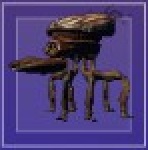 |
1.9m 69kg |
Somarinoa | Bait: Fermented Fruit
| |
 |
1.9m 86kg |
Somarinoa | Bait: Fermented Fruit
| |
| 0.7m 70.6kg |
Somarinoa | The Lamadi is a common species of nervous scavengers. Despite their intimidating appearance, they are afraid of many species larger than them and are dirty creatures that scavenge as much of their needed nutrients from the coprite droppings of other species. They are covered in skin parasites that can easily transfer to other creatures, causing bad skin irritation. They utilize a prime, sexually mature gender that rules over secondaries that are unable to breed until a chemical signal goes off that lets them begin to mature into primes.
| ||
 |
2.2m 120kg |
Somarinoa | Bait: Sweetend Compost
Gender(s): Indeterminate Behavior: Vigilant Diet: Star Bramble Notes: Carries symbiotic worms | |
 |
0.8m 30.9kg |
Somarinoa | The Nodershan Trufflefish is a common species of fish-like creature adapted to life in large bodies of water. Their gender is not outwardly noticeable and requires dissection to confirm, which of course kills the creature in doing so. They may travel in loose shoals of their own kind but lead lonely existences, not interacting with the others beyond mating. They dig for tubers to eat using their long rostrums. Because their eyes are eaten by some other species, they can regenerate their damaged eyes after about a month.
| |
 |
1m 64.1kg |
Somarinoa | The Nodershan Walkingfish is an uncommon species of vigilant-yet-fragile skinned creatures which wander the wet environments of the planet seeking oxide elements to supplement their dietary needs. They are genderless and breed via spawning, first releasing eggs into a body of water and then seeking out another body of water to fertilize the eggs of others of their species.
| |
 |
Microscopic to the size of an average human hand | Somarinoa | Living, amoebic slime colony-organism that is known to feed on electrical circuitry. Considered a pest species. Rythmically thrums as if it has a makeshift heartbeat. | |
| 2.1m 108.5kg |
Somarinoa | Bait: Synthetic Worms
| ||
 |
???m ???kg |
Somarinoa | Primary Element: Sodium
| |
 Smorgasworm |
???m ???kg |
Somarinoa | Large, aquatic relative of palateworms. Hardened shell contains heavy levels of Crystal Sulphide. | |
|
|
1.4m 82.1kg |
Somarinoa | Bait: Enzyme Fluid
| |
 |
1.4m 95.2kg |
Somarinoa | Bait: Fermented Fruit
| |
| 2.2m 106.5kg |
Somarinoa | Bait: Scented herbs
| ||
Sapients[]
| Name | Harvestable materials | Discoverer | Description | |
|---|---|---|---|---|
 Oqueina (Oqueina portkasia) |
Carbon Star Bulb |
Somarinoa | Aging Style: Moderate (Perennial)
| |
Minerals[]
| Name | Primary / Secondary Element | Described by | Notes | |
|---|---|---|---|---|
| Azuruokaite | Ferrite Dust Paraffinium |
Somarinoa | Metal Content: 44%
| |
 Edwarite |
Somarinoa | Metal Content: 47%
| ||
 Eloreite |
Somarinoa | Metal Content: 51%
| ||
| Ferrite Dust | Somarinoa | Metal Content: 75%
| ||
 Ganiocite |
Cobalt/Gold/Silver Nitrogen |
Somarinoa | Metal Content: 45%
| |
Genburite |
Pure Ferrite Paraffinium |
Somarinoa | Metal Content: 64%
| |
 Gwoodite |
Somarinoa | Metal Content: 49%
| ||
 Hodinezite |
Somarinoa | Metal Content: 64%
| ||
 Lacarpite |
Ferrite Dust Paraffinium |
Somarinoa | Metal Content: 67%
| |
 Lomstavite |
Chlorine Di-hydrogen |
Somarinoa | Metal Content: 54%
| |
 Niumptiite |
Ferrite Dust Paraffinium |
Somarinoa | Metal Content: 49%
| |
 Nulotemite |
Somarinoa | Metal Content: 66%
| ||
 Okayalite |
Somarinoa | Metal Content: 71%
| ||
 Otycoheite |
Ferrite Dust Paraffinium |
Somarinoa | Metal Content: 56%
| |
 Pipkeaite |
Chlorine Di-hydrogen |
Somarinoa | Metal Content: 70%
| |
 Sattakerite |
Somarinoa | Metal Content: 48%
| ||
 Sevanaite |
Salt Oxygen |
Somarinoa | Metal Content: 46%
| |
 Uyeloite |
Somarinoa | Metal Content: 76%
| ||
 Yukovskite |
Crystal Sulphide | Somarinoa | Metal Content: 66%
| |
Notable Colonists[]
The planet is barely inhabited, with only a handful of Geks being willing to put up with the near-constant torrential heatstorms that bombard the surface every few minutes. As of the last census taken, AI modules outnumber actual colonists on the planet.
Species Members[]
AIs[]
Gallery[]
Food Web Collapse Extinction Event (NEXT)[]
The planet during its discovery by the Loranches, at the beginning of the Food Web Collapse Disaster.
Extinction Aftermath (Origins)[]
The planet after the Food Web Collapse Disaster event that wiped out much of the fauna life on the planet.
Shocklog Rampancy Situation (Origins)[]
Shocklog, a trade terminal AI in the Adtowcest Everglades goes rampant, hacking into the control systems for the Shield of the Ankoku, leaving the Loranche explorer Somarinoa stranded without a way off the planet. He must chase down his vessel in a vain attempt to reclaim control.



